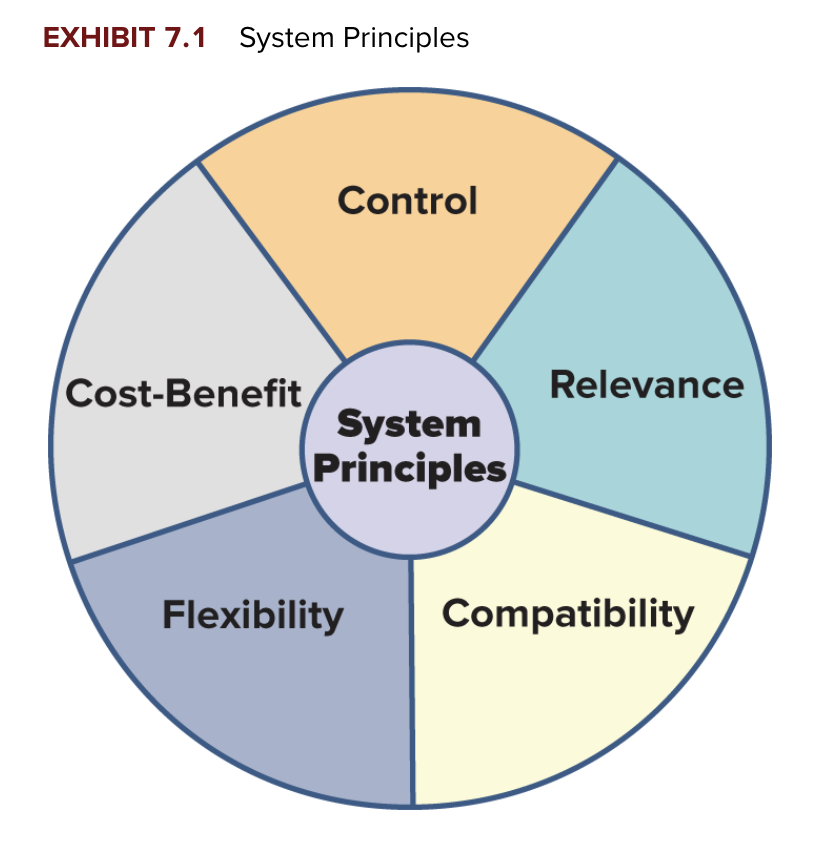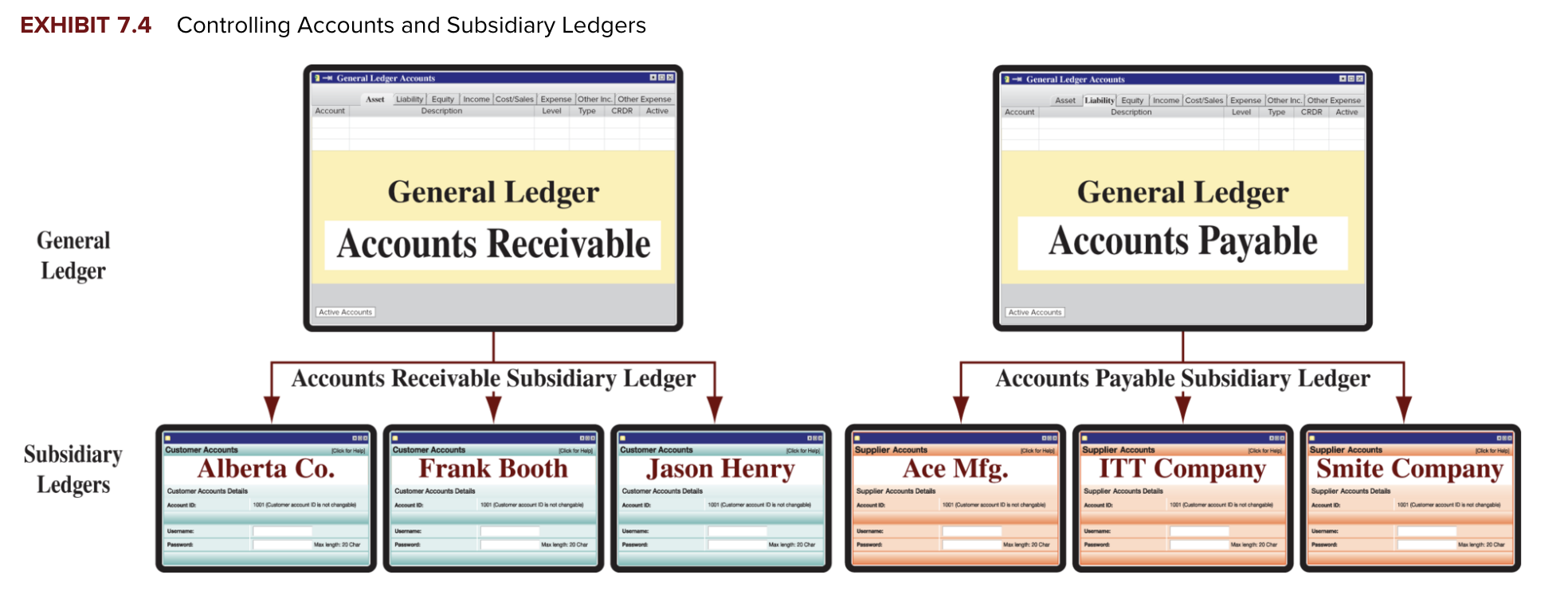7 - Accounting Information Systems #1
1/29
There's no tags or description
Looks like no tags are added yet.
Name | Mastery | Learn | Test | Matching | Spaced |
|---|
No study sessions yet.
30 Terms
What do accounting information systems (AIS) do?
a. Collect and process data from transactions and events, organize them in reports, and communicate results to decision makers
b. Help users make more informed decisions and better understand the risks and returns of different strategies

What are the five main principles in accounting information systems?
Control
Relevance
Compatibility
Flexibility
Cost-Benefit
What are internal controls?
procedures that help managers control and monitor business activities. Includes policies to protect company assets and ensure compliance with laws/regulations
Describe the Control Principle
prescribes that an accounting information system has internal controls
Describe the Relevance Principle
prescribes that an accounting information system reports useful, understandable, and timely information for decision making
Describe the Compatibility Principle
prescribes that an accounting information system conforms with a company's activities, personnel, and structure
Eg. Amazon requires a huger, automated system; a small retail shop only needs a simple system
Describe the Flexibility Principle
prescribes that an accounting information system be able to adapt to changes in the company, business environment, and the needs of decision makers
Technological advances, competitive pressures, consumer tastes, regulations, and company activities constantly evolve
A system must be designed to adapt to these changes
Eg. Tech: AI, cloud systems, new software
Eg. Customer preference for online shopping → AIS must track online sales
Describe the Cost-Benefit Principle
prescribes that the benefits from an activity in an accounting information system outweigh the costs of that activity
Decisions about other system principles (control, relevance, compatibility, and flexibility) are also affected by the cost-benefit principle
What are the five components of an accounting system?
Source documents
Input devices
Information processors
Information storage
Output devices

Do the give components of an accounting system only apply if a system is computerized?
No, they apply whether a system is computerized or manual
Describe SOURCE DOCUMENTS
Provide the information processed by an accounting system
Eg. Bank statements and checks, invoices from suppliers, customer bills, sales receipts, employee earning records
Why is it crucial to have accurate source documents?
the input of wrong information damages the reliability of the accounting information system
Describe INPUT DEVICES
take information from source documents and transfer it to information processing (eg. keyboards and scanners)
Journal entries are a type of input device
Describe INFORMATION PROCESSORS
summarize information for use in analysis and reporting
Includes journals, ledgers, working papers, and posting procedures
Helps transform raw data into useful info
Describe INFORMATION STORAGE
keeps data accessible to information processors
Auditors pull from a database when auditing financial statements and company controls
Also used for future analyses and reports
CLOUD STORAGE!!
Describe OUTPUT DEVICES
make accounting information available to users
Includes printers, monitors, smartphones, etc
Output devices provide users with a variety of items, including customer bills, financial statements, and internal reports
What is a general journal?
An all-purpose journal in which we can record ANY transaction
Used for transactions not covered by special journals, as well as adjusting, closing, and correcting entries
What is important about a special journal?
Groups transaction of a similar type; helps to enhance internal control and reduce costs
Accumulate debits and credits of similar transactions and post column totals rather than individual amounts
Allows for efficient division of labor and serves as an effective control procedure
Special journals are different for various types of businesses and are created for the most common transactions

What are very common transactions?
Sales, cash receipts, purchases, and cash payments (disbursements)
What is a subsidiary ledger?
A list of individual accounts with a common characteristic that provides detailed information supporting a general ledger account
Think of it as a detailed breakdown of certain accounts in the general ledger, organized by a common characteristic (eg. customers or suppliers)
The subsidiary ledger shows who owes what or who you owe what
What does a subsidiary ledger do?
It contains detailed information on specific accounts in the general ledger (supporting the control account)
What is the Accounts Receivable Subsidiary Ledger?
A ledger that stores transaction data and balances for individual customers

What is the Accounts Payable Subsidiary Ledger?
A ledger that stores transaction data and balances for individual suppliers

Why do companies use an Accounts Payable control account?
To track the total amount owed to all suppliers, while the subsidiary ledger tracks individual supplier balances
T/F: The Accounts Receivable account is said to control the accounts receivable (subsidiary) ledger and is called a controlling account
True, the A/R account is the GL is called a controlling account since:
Its balance must EQUAL the SUM of all individual customer balances in the subsidiary ledger
It “controls” or summarizes the detailed info kept in the subsidiary ledger
What is a control account?
any general ledger account that summarizes subsidiary ledger data or details. It is an account that “controls” a specific subsidiary ledger
eg. “We owe $45,000 in TOTAL”
Eg. The A/P subsidiary ledger would detail that Supplier A owes $10,000, Supplier B owes $20,000, and Supplier C owes $15,000.
Are subsidiary accounts only used to A/R and A/P?
No, they are used for several other accounts
A company may have one Equipment account in the GL, but its equipment subsidiary ledger could record each type of equipment in a separate account
What are the benefits of subsidiary ledgers?
Remove clutter from the general ledger (keep it simple)
Provide up-to-date, detailed information on specific customers, suppliers, equipment, etc.
What is the relationship between a control account and its subsidiary ledger?
The total of all subsidiary ledger accounts must equal the balance in the control (account)
Why might a company use an equipment subsidiary ledger?
To track individual pieces or types of equipment, even though the general ledger has only one Equipment account